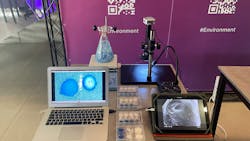Lithuanian research develops fast microorganism carrier
A team of researchers from Kaunas University of Technology (KTU), Lithuania, have developed an new method for delivering microorganisms to treat contaminated water.
The method uses hydrogel granules made from polyvinyl alcohol (PVA) as a biological carrier for microorganism cultures, which decompose pollutants in wastewater. According to the researchers, the treatment works up to five times faster compared to conventional methods.
In May 2022, the invention was awarded a winning prize in the annual KTU innovation fair Technorama.
Sized 3-4 mm in diameter, the hydrogel granules have a porous structure made of macropores of up to 20 microns – an appropriate size to immobilize microorganisms – that serve as a biological carrier.
“Inside the pores of the granules, cultures of microorganisms that decompose pollutants in wastewater can live. The network of pores in the PVA hydrogel granules, ensures a constant supply of oxygen and nutrients to the bacteria inside the granules, thus creating a highly durable and efficient biological wastewater treatment system,” says Judita Švaikauskaitė, a young researcher at KTU.
PVA hydrogel granules are mechanically stable and therefore suitable for long-term use. The bacteria play a significant role in this process – they use ammonia, phosphate, organic compounds, and other dangerous chemical substances as nutrient and energy sources. A wide spectrum of bacteria can be immobilized inside a gel granule. PVA hydrogel granules demonstrate great absorption capacities for organic micropollutants and pharmaceuticals.
“PVA hydrogel granules not only increase the efficiency of the biological wastewater treatment system but also have excellent sorption properties in removing residues of pharmaceutical substances and other micro-pollutants from wastewater,” says Švaikauskaitė.
The environmentally friendly solution was created by Švaikauskaitė together with KTU Department of Environmental Technology researchers Inga Urniežaite and Vytautas Abromaitis. Their invention stood out among more than 70 teams who presented ideas for new technologies and scientific innovations in the Technorama’22 exhibition.
